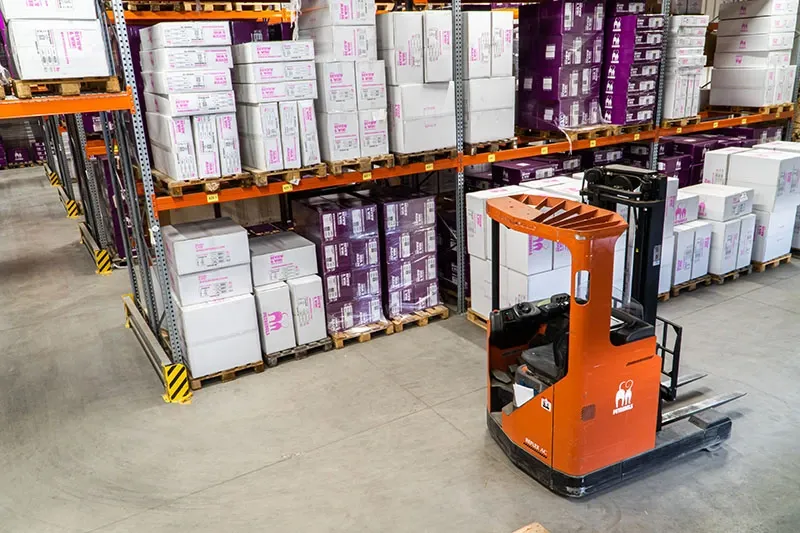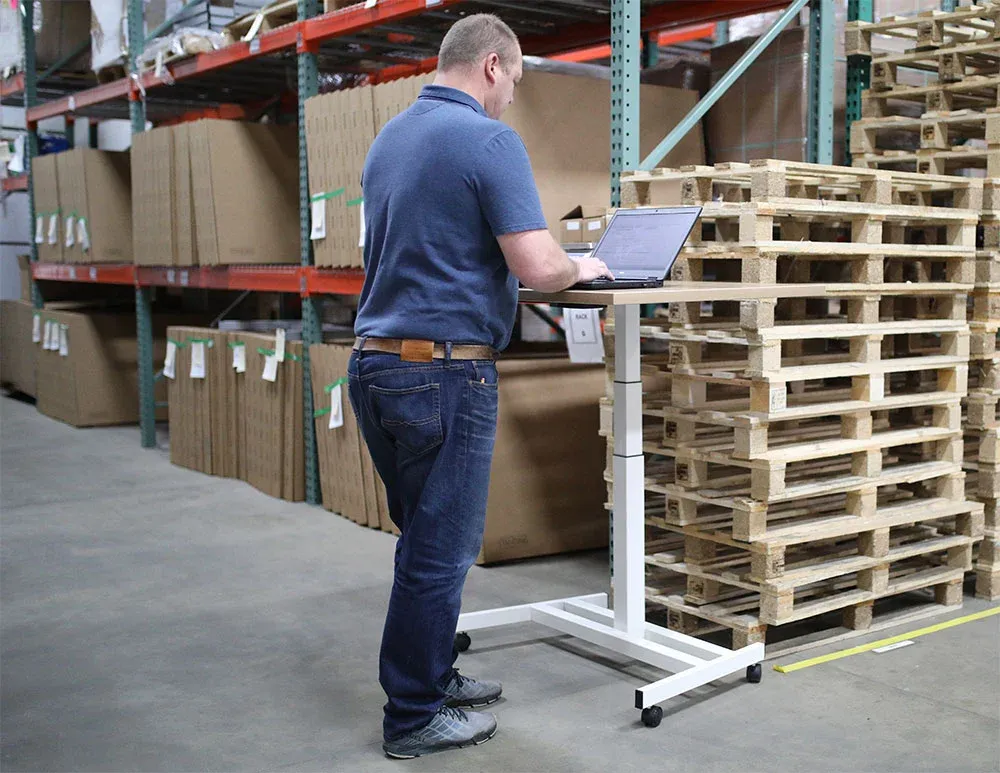WMS Software
Elevate your warehouse management to new heights with FleetGO’s Warehouse Management Software (WMS). Our innovative solution is designed to streamline warehouse operations, ensuring optimal efficiency and accuracy at every step.
Warehouse Management Software
Our Warehouse Management Software is a powerful, comprehensive and extremely flexible solution that provides real-time inventory visibility and control. It enables businesses to effectively manage stock levels, streamline picking and packing processes, and improve overall warehouse efficiency.
Our WMS software empowers some of Europe’s largest warehouses and has a strong track record. It’s renowned to be the ideal application to control your logistics
Our WMS supports its customers not only in terms of efficiency and optimisation possibilities but is also characterised by high acceptance among users in daily practice.
The ultimate WMS for any situation
Our WMS is a comprehensive solution that provides you with the tools to manage and optimise your warehouse operations seamlessly. With real-time visibility into your inventory, automated processes for increased accuracy, and intelligent analytics for informed decision-making, our system is built to take your warehouse management to the next level.
No matter the size or complexity of your warehouse, our WMS adapts to your needs, providing a highly customizable platform that grows with your business. Whether you’re looking to reduce costs, enhance productivity, improve customer service, or all of the above, our WMS is the partner you need.

WMS Software advantages
Cost reduction due to fewer shortages
Time savings through optimized processes
Increased inventory security with better disposition options
Reduced excess inventories of individual items
Increased efficiency by forward-looking planning
Productivity increase with paperless picking
Full transparency about what is happening in the warehouse
Quality assurance through complete documentation
Optimal personnel planning through better utilisation
Shorter employee training period
Coordination of employees by the control station
More happy employees and customers!
We are more than software developers: we are warehouse experts.
At FleetGO, we are more than just software developers. We are industry veterans with deep-rooted knowledge and expertise in warehouse management. Our experience extends beyond the digital realm, reaching into the heart of warehouses – the place where the real action happens.
We understand the ins and outs of warehouse operations, the unique challenges faced, and the high demands placed on businesses in the sector. Our understanding of warehouse logistics is not theoretical but rooted in practical experience. We’ve seen firsthand the difference efficient warehouse management can make and have dedicated our careers to helping businesses realize this potential.

WMS Software feature overview
No warehouse is the same so our WMS is built to be highly flexible and adjustable to any situation. Below we’ve listed some of the most important features our software offers:
Core features
- Warehouse floor plan
- Inventory management
- Master data management
- Transport management
- Goods received
- Outgoing goods
- Internal processes
In order to replicate the diversity in the warehouse structures and thus guarantee its customers the best possible performance, PraMag uses various classification criteria:
- Division into zones
The basic division into zones, e.g. goods receipt, collection zone, reserve zone, etc., allows a wide variety of process sequences to be mapped later. - Division according to storage areas
To control the warehouse processes, the warehouse is divided into different storage areas. The assignment of the storage, retrieval and picking areas is done per storage place. - Row place compartment format
This enables a three-dimensional mapping of a storage place. The definition of the row-place-compartment format is essential for flexibility in warehouse conversions or expansions and decisive for orientation in the warehouse. - Storage place attributes
Different attributes can be assigned to each storage place (e.g. physical storage block, occupied/not occupied, capacity and capacity monitoring, ABC area, etc.). - Warehouse modeling
The storage places are created in the Stock Information program. By assigning various attributes, the warehoues floorplan is mapped according to the physical requirements and the intended optimizations in the warehouse.
PraMag can map any number of locations of a company. In doing so, each site can be mapped according to its individual logical or physical organizational units, such as
- Warehouse types
Pallet warehouse, high-bay warehouse, small parts warehouse, block warehouse, open-space warehouse - Storage areas
also warehouse subareas, storage places, activity areas (work areas, transport areas, picking areas, and many more) can be configured.
Together with easy-to-understand warehouse configuration and high adaptability flexibility (especially during live operation), we ensure best possible site management and high practical everyday usability.
Inventory management includes functionalities and methods for managing and finding the same as well as different inventory levels. With PraMag you master
- Inventory management accurate to storage location
- Inventory management by stock-separating characteristics.
Batch, best before date, version, quota, blocking indicator - Inventory management by inventory type
free, blocked, quality blocked - Use of strategies
Stocking strategies, stock transfer strategies, stock removal strategies and stock reservation strategies based on a wide range of adjustable parameters - Booking history
All goods and TM movements within a warehouse can be tracked with a wide range of information - Storage
Chaotic warehousing (free choice of storage location by the system), warehousing with fixed locations - Printing of article labels and storage place labels
- Different storage options of single-article or mixed load carriers
- Digital warehouse floorplan and path network
The so-called “route network double play” is used to optimize routes and avoid unnecessary trips.
With master data management, the basic information that remains valid for a long period of time and that is relevant for the operation of a warehouse, is mapped and maintained. Master data can apply to one location as well as to all locations.
In PraMag, all important master data objects such as customers, suppliers (clients, administrators), means of transport, branches and staff can be managed. In addition to data exchange via interfaces, it is also possible to create and maintain data independently of an interface.
Article master data
- Basic data
Article description, EAN, weight, dimensions, remaining shelf life, stock-separating characteristics such as BBD, batch, version, quota, etc. - Warehouse-specific (branch-related) data
Strategies, over-delivery tolerances, classification ABC areas, etc.
Transportation means master data
- Management of all common TM types
e.g. pallet, box, container, tray, carton, corlette and many more incl. dimensions - Account management
Load/unload customer, warehouse, forwarder, etc.
Branches
- Multi warehouse capability, settings for residual quantity counting, etc.
Customer master data
- Customers
- Clients
- Manager
- Warehouse
- Suppliers
User management
- User authorization
Assignment of an ID and individual permissions - Role management
Authorizations are granted via assignment to a role. Roles facilitate the large-scale assignment of authorizations for a large number of employees.
In PraMag, transport management is performed by
- Determination of forklift groups
Linking of forklift groups and work areas and storage of further parameters important for transport (full pallet transports, sequence/priority of work areas to be processed, etc.) - Definition of work areas
- Consideration of stage places.
Transport from A to B via G
In PraMag we distinguish between
- Relocate
move a load carrier (LGT) from a source location to a destination location - Rearrangement
Bring partial quantity of an item from one LGT to another LGT
Goods Receiving (GR), is the area where goods are physically received, checked, recorded and stored and is therefore one of the most important processes in a warehouse. It must be handled with great care, because every error subsequently leads to problems and unnecessary rework in one of the downstream warehouse processes. In PraMag, the process basically looks like this:
- Notification
Orders can be created and processed in PraMag either manually or automatically (if the data is transmitted via an SST from the upstream ERP system) - Order positions
are created as notified stock (virtual stock) - Taking over
The goods are received via scan with the MDE; actual stocks are compared against the notificated stock and posted to a GR place - Deconsolidation
If necessary, deconsolidation takes place prior to taking over. - Quality check
takes place according to the corresponding specification by the ERP system - Storage
the target search for storage is carried out on the basis of defined strategies and taking into account other parameters such as material groups (hazardous goods, heavy goods, etc.), permissible loading equipment types, storage zones, storage place dimensions (including height assessment), etc. - Inventory feedback
Confirmation of the received goods to the ERP takes place
other options:
- Commission goods
Customer-related goods orders are marked separately by allocating a quota and are later taken into account in stock reservations. - Cross-Docking Processes.
can be identified, managed and controlled using various parameters in the order or in the goods. A complete storage of the goods is not necessary.
Goods issue is the area in which the goods to be delivered are physically removed from storage and booked out on the inventory side. In addition to the reservation/picking of the goods, the goods issue process also includes the recording of loading equipment as well as the control at staging or goods issue places. In PraMag, the process basically looks like this:
- Order management
Orders can be created and processed in PraMag either manually or automatically (if they are transmitted via an SST from the upstream ERP system). - Order positions
Based on the order positions and taking into account existing stock-defining characteristics (including quota goods), goods are reserved in the warehouse and
picking tasks are formed - Reservation of the stock
In the standard system, FIFO is used; FEFO is used for articles with an expiration date; LIFO can also be set. - Picking
The picking of the goods is done with the MDE and usually route-optimized (if necessary taking into account the weight or dangerous goods regulations, etc.). - Choice between guided picking and free picking.
The collector is guided to the storage place of the reserved goods or the collector decides independently from which storage place he picks the goods - Target search
The destination search for picked goods is carried out based on defined strategies and taking into account other parameters such as port specifications, specifications from the order (among others repacking specifications, existing packing stations, shipping places for parcel services, etc.). - **Consolidation
Optionally, goods can be consolidated or compacted in goods issue before loading - Packing
Printing of shipping labels and SSCC, delivery bills, freight documents - Shipping
After processing all tasks for a tour, loading takes place (taking into account the loading sequence) - Delivery feedback
At the end of the tour, the picked goods and the empties used are reported back to the ERP.
Adjustable are
- multi-level picking
- Block picking
- Order-, customer- or tour-related picking
- Consideration of full pallets and break-off quantity
- voucherless or voucher-based picking
- Override FIFO and FEFO if required
Relocation
In the process of stock transfer, a load carrier (LGT) with goods is moved from a source bin to a new destination bin on the basis of a transfer order (TO) (planned stock transfer). LGT can also be moved without an existing TO (unplanned stock transfer).
Relocation: planned/unplanned stock transfers
Rearrange: subsets of an item are transferred from a source LGT to a target LGT
Return to storage: creation of transfer orders for clearing the collection zone
Supply
If a quantity of an item is required for picking, a stock transfer takes place in the form of a replenishment (from the reserve zone to the collection zone).
- planned (creation of TA on the basis of consumption values)
- Unplanned (by picker)
- Quantity determination of replenishment e.g. from min./max. quantity; consideration of order quantities of open orders, etc.
Rebooking
During a transfer posting, at least one attribute of a position is changed in the system. Permission to perform via appropriate authorizations ensures the unauthorized use of this option.
- Stock changes (attribute change, e.g. blocking indicator)
- Inventory corrections (quantity changes) usually with specification of cost centers
- Feedback to the ERP system
Stocktaking
A stocktaking is creating an inventory of all stocks. In PraMag, each inventory is performed at the storage place level. The places to be counted are grouped into tasks. The tasks are processed on the MDE, compared with the book inventory in the inventory program and, if necessary, recounts are created. A feedback to the ERP system is possible. The inventory is supported in various forms (e.g., annual inventory, perpetual inventory). In PraMag, the process of an annual inventory basically looks like this
- Creation of an inventory incl. inventory tasks
- Task processing at the MDE
- Control and reconciliation via inventory program
- Feedback to the ERP system
Other supported inventory types:
- permanent inventory
- Empty space counting or empty space inventory
- Residual quantity counting
Control station
The control station is used to provide an overview and to track all ongoing processes within the scope of picking, staging and loading. Various functions can be used to intervene in the operational processes.
- Display of all tours of a day incl. progress of picking, loading quantity, total weight, etc.
- Priority control of the tours
- Display of the individual orders of a tour, assigned pickers, means of transport used, current storage location, etc.
- Possibility of manual intervention in reservation, release picking, staff deployment (collector allocation), shorten delivery order, process shortages, transport control, etc.
- Online notification in case of shortages or stock differences, cancelled transfer orders or blocked storage places
- Communication with collector via message function
- Printing of shipping documents (receipts, waybills, export documents) and shipping labels
About configuration options are also available:
Delivery feedback to the ERP about the status in processes, e.g. in order picking
- Reservation made
- Picking started
- Goods provided
- Goods loaded
Additional features
| Cross docking |
| Batches |
| Hazardous goods/substances |
| Weight control |
| Handling units management |
| Empties and loading equipment management |
| (Multi-)client capability |
| Multi-warehouse capability |
| Material flow |
| Best before dates |
| Production supply |
| Returns |
| Slotting and warehouse reorganization |
| Serial numbers |
| Scrapping |


